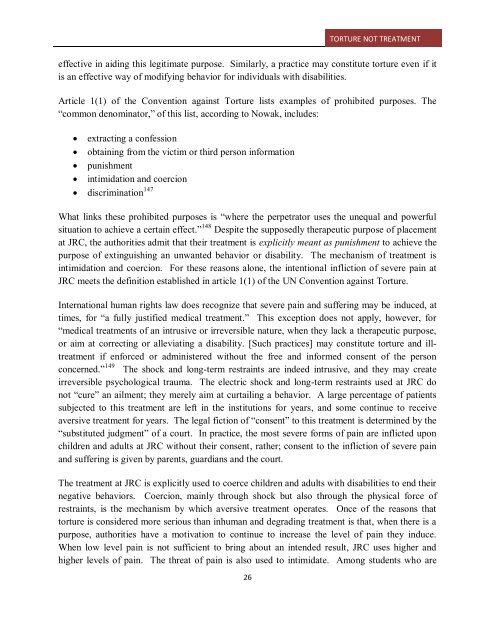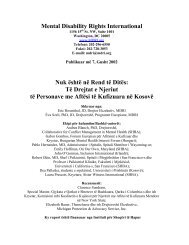Torture not Treatment - Disability Rights International
Torture not Treatment - Disability Rights International
Torture not Treatment - Disability Rights International
Create successful ePaper yourself
Turn your PDF publications into a flip-book with our unique Google optimized e-Paper software.
TORTURE NOT TREATMENT<br />
effective in aiding this legitimate purpose. Similarly, a practice may constitute torture even if it<br />
is an effective way of modifying behavior for individuals with disabilities.<br />
Article 1(1) of the Convention against <strong>Torture</strong> lists examples of prohibited purposes. The<br />
―common denominator,‖ of this list, according to Nowak, includes:<br />
extracting a confession<br />
obtaining from the victim or third person information<br />
punishment<br />
intimidation and coercion<br />
discrimination 147<br />
What links these prohibited purposes is ―where the perpetrator uses the unequal and powerful<br />
situation to achieve a certain effect.‖ 148 Despite the supposedly therapeutic purpose of placement<br />
at JRC, the authorities admit that their treatment is explicitly meant as punishment to achieve the<br />
purpose of extinguishing an unwanted behavior or disability. The mechanism of treatment is<br />
intimidation and coercion. For these reasons alone, the intentional infliction of severe pain at<br />
JRC meets the definition established in article 1(1) of the UN Convention against <strong>Torture</strong>.<br />
<strong>International</strong> human rights law does recognize that severe pain and suffering may be induced, at<br />
times, for ―a fully justified medical treatment.‖ This exception does <strong>not</strong> apply, however, for<br />
―medical treatments of an intrusive or irreversible nature, when they lack a therapeutic purpose,<br />
or aim at correcting or alleviating a disability. [Such practices] may constitute torture and illtreatment<br />
if enforced or administered without the free and informed consent of the person<br />
concerned.‖ 149 The shock and long-term restraints are indeed intrusive, and they may create<br />
irreversible psychological trauma. The electric shock and long-term restraints used at JRC do<br />
<strong>not</strong> ―cure‖ an ailment; they merely aim at curtailing a behavior. A large percentage of patients<br />
subjected to this treatment are left in the institutions for years, and some continue to receive<br />
aversive treatment for years. The legal fiction of ―consent‖ to this treatment is determined by the<br />
―substituted judgment‖ of a court. In practice, the most severe forms of pain are inflicted upon<br />
children and adults at JRC without their consent, rather; consent to the infliction of severe pain<br />
and suffering is given by parents, guardians and the court.<br />
The treatment at JRC is explicitly used to coerce children and adults with disabilities to end their<br />
negative behaviors. Coercion, mainly through shock but also through the physical force of<br />
restraints, is the mechanism by which aversive treatment operates. Once of the reasons that<br />
torture is considered more serious than inhuman and degrading treatment is that, when there is a<br />
purpose, authorities have a motivation to continue to increase the level of pain they induce.<br />
When low level pain is <strong>not</strong> sufficient to bring about an intended result, JRC uses higher and<br />
higher levels of pain. The threat of pain is also used to intimidate. Among students who are<br />
26




